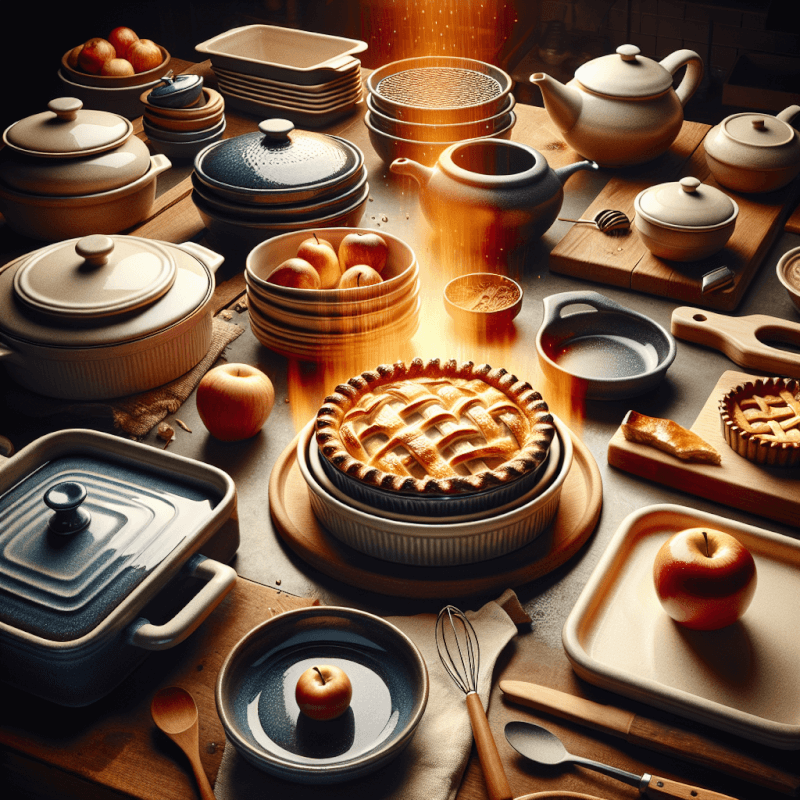Imagine a world where baking is a breeze and every cake and batch of cookies turns out perfectly golden and mouthwateringly delicious. Enter bakeware ceramic, the game-changing material that is taking the culinary world by storm. With its durable yet lightweight construction, bakeware ceramic is the ideal choice for all your baking needs. Whether you’re a seasoned baker or a newbie in the kitchen, this article will explore the benefits and versatility of this remarkable material and leave you inspired to create culinary masterpieces with ease. Say goodbye to burnt bottoms and uneven bakes, and say hello to bakeware ceramic – your new baking best friend.
What is Bakeware Ceramic?
Bakeware ceramic refers to a type of cookware that is specifically designed for baking purposes. This versatile material is known for its excellent heat distribution, non-stick properties, and durability. It is made from a combination of clay and other natural materials, which are then fired at high temperatures to create a strong and smooth surface. Bakeware ceramic is a popular choice among home cooks and professional bakers alike due to its ability to produce delicious and evenly cooked baked goods.
Advantages of Bakeware Ceramic
Heat Distribution
One of the key advantages of bakeware ceramic is its ability to evenly distribute heat throughout the baking process. The ceramic material absorbs and retains heat, allowing for consistent and even baking. This ensures that your cakes, breads, and other baked goods are cooked to perfection, with no burnt edges or undercooked centers. The heat distribution properties of bakeware ceramic also mean that you can achieve a golden brown crust on your pastries and breads, giving them an attractive and appetizing appearance.
Non-Stick Properties
Another great advantage of bakeware ceramic is its non-stick properties. The smooth surface of ceramic bakeware prevents food from sticking to the pan, making it easier to clean and ensuring that your baked goods come out effortlessly. Unlike traditional metal bakeware, you don’t have to worry about greasing or using parchment paper to prevent sticking. This makes bakeware ceramic a healthier option, as you can reduce the amount of oil or butter used in your recipes.
Versatility
Bakeware ceramic is a highly versatile material that can be used for a wide range of baking needs. From casseroles and lasagnas to pies and muffins, there is a ceramic bakeware piece designed for every dish. Ceramic casserole dishes are perfect for slow-cooking savory meals, while baking pans and pie plates are excellent for making crispy and evenly cooked pastries. Muffin tins made from ceramic provide even heat distribution, ensuring perfectly baked muffins and cupcakes. The versatility of bakeware ceramic allows you to explore and experiment with different recipes and cooking techniques.

Types of Bakeware Ceramic
Casserole Dishes
Casserole dishes made from bakeware ceramic are a staple in any kitchen. These deep dishes are perfect for baking casseroles, lasagnas, and other savory dishes that require slow and even heat distribution. The depth of the dish allows for layering ingredients and retaining moisture, resulting in tender and flavorful meals. Bakeware ceramic casserole dishes often come with lids, which help to seal in the heat and enhance the cooking process. They are available in various sizes, allowing you to choose the one that best suits your needs.
Baking Pans
Bakeware ceramic baking pans are the go-to choice for baking cakes, cookies, and other sweet treats. These pans come in different shapes and sizes, including round, square, and rectangular options. The smooth surface of the ceramic ensures that your baked goods have a beautiful golden brown crust and easily release from the pan. Bakeware ceramic baking pans are also durable and resistant to scratches, ensuring that they will last for many years.
Pie Plates
Pie plates made from bakeware ceramic are a must-have for any pie enthusiast. The even heat distribution of ceramic ensures that your pie crust bakes to a perfect golden brown, while the deep sides prevent filling from spilling over during baking. Bakeware ceramic pie plates are available in various sizes and designs, allowing you to choose the perfect plate for your favorite pie recipes. They are also microwave and oven-safe, making it convenient to reheat leftover pie slices.
Muffin Tins
Bakeware ceramic muffin tins are a game-changer for muffin and cupcake enthusiasts. These tins provide excellent heat distribution, resulting in evenly baked muffins with beautifully domed tops. The non-stick properties of ceramic make it easy to remove the muffins from the tin without any sticking or tearing. Bakeware ceramic muffin tins are available in different sizes, allowing you to bake large or mini muffins depending on your preference. With a ceramic muffin tin, you can enjoy bakery-quality muffins in the comfort of your own home.
Choosing the Right Bakeware Ceramic
Size and Shape
When choosing bakeware ceramic, it is important to consider the size and shape of the piece. The size of the pan or dish should align with the amount of food you intend to cook. If you often cook for a large group or enjoy batch cooking, larger baking pans or casserole dishes would be appropriate. On the other hand, if you tend to cook for smaller portions or enjoy baking individual servings, smaller pans or ramekins would be more suitable. Additionally, consider the shape of the bakeware ceramic. Round pans are commonly used for cakes, while rectangular or square pans are ideal for baking bars and brownies.
Quality and Durability
Another crucial factor to consider when choosing bakeware ceramic is the quality and durability of the material. High-quality bakeware ceramic is less prone to chipping, cracking, or warping, ensuring that it will last for many years. Look for reputable brands that offer well-crafted pieces made from premium materials. It is also advisable to read customer reviews and testimonials to get an idea of the durability and performance of the product. Investing in high-quality bakeware ceramic may be slightly more expensive initially, but it will save you money in the long run as you won’t have to replace your bakeware frequently.
Maintenance
Consider the maintenance requirements of bakeware ceramic before making a purchase. Some bakeware ceramic pieces are dishwasher safe, making cleanup a breeze. However, others may require handwashing to preserve their quality and prevent any damage. Additionally, check if the bakeware ceramic is microwave and freezer-safe, as this can add to its versatility and convenience. It is important to follow the manufacturer’s instructions for proper care and maintenance to ensure the longevity of your bakeware ceramic.

How to Use Bakeware Ceramic
Preparation
Before using bakeware ceramic, it is important to properly prepare the surface to prevent sticking and ensure even heat distribution. If your ceramic bakeware is seasoned or has a non-stick coating, follow the manufacturer’s instructions for any specific preparation steps. For uncoated ceramic bakeware, it is a good practice to lightly grease the surface before adding your batter or dough. Although ceramic is known for its non-stick properties, a thin layer of oil or cooking spray will help ensure that your baked goods release easily from the pan.
Temperature Recommendations
When using bakeware ceramic, it is important to carefully consider the temperature recommendations provided by the manufacturer. Ceramic bakeware can generally withstand high temperatures without warping or cracking. However, extreme temperature changes can cause thermal shock, which may lead to damage. It is always recommended to preheat your oven and allow the ceramic bakeware to gradually reach the desired temperature. Avoid placing cold ceramic bakeware directly into a hot oven or transferring hot ceramic bakeware to a cold surface. Following these temperature recommendations will help preserve the integrity of your bakeware ceramic.
Cleaning Tips
Cleaning bakeware ceramic is a relatively simple process, especially if the bakeware is dishwasher safe. If your ceramic bakeware has any food residue or stains, soak it in warm soapy water for a few minutes to loosen the particles. Use a non-abrasive sponge or cloth to gently scrub the surface, rinsing with warm water afterward. Avoid using harsh cleaning agents or abrasive scrubbers, as they can damage the ceramic coating. If necessary, use a baking soda paste to remove stubborn stains or odors. After cleaning, allow your bakeware ceramic to air dry completely before storing it.
Caring for Bakeware Ceramic
Avoiding Thermal Shock
One of the most important aspects of caring for bakeware ceramic is avoiding thermal shock. Thermal shock occurs when there is a sudden and extreme change in temperature, causing the ceramic to expand or contract rapidly. This can lead to cracking or breaking of the bakeware. To avoid thermal shock, it is important to gradually heat or cool your ceramic bakeware. For example, if you are transitioning from the refrigerator to the oven, allow your bakeware ceramic to come to room temperature before placing it in the preheated oven. Similarly, when removing hot bakeware from the oven, place it on a heat-resistant surface or cooling rack instead of a cold countertop.
Storing Properly
Proper storage is essential to prolong the lifespan of your bakeware ceramic. To prevent damage, avoid stacking heavy items on top of each other, as this can lead to chipping or cracking. If space is limited, consider using protective padding or dividers to separate the pieces. It is also advisable to store your bakeware ceramic in a cool and dry area to prevent any moisture buildup. Ensure that your bakeware ceramic is completely dry before storing to avoid any potential mold growth. Taking these simple steps will help you maintain the quality and performance of your bakeware ceramic for many years to come.

Recipes and Ideas to Try with Bakeware Ceramic
Baking Bread
Bakeware ceramic is an excellent choice for baking bread due to its ability to provide even heat distribution and a beautiful crust. You can use a round or rectangular ceramic baking pan to shape and bake your bread dough. The depth of the pan will allow the dough to rise properly, resulting in a soft and fluffy interior. Whether you prefer classic white bread, flavorful whole wheat bread, or artisan sourdough, bakeware ceramic is sure to produce outstanding results.
Roasting Vegetables
Bakeware ceramic is not limited to sweet treats and baked goods; it can also be used for roasting vegetables. The even heat distribution of ceramic ensures that your vegetables are cooked to perfection, with a tender interior and crispy exterior. Simply toss your favorite vegetables in olive oil, season with herbs and spices, and spread them evenly on a ceramic baking sheet. Roast in the oven until golden and delicious. The natural flavors of the vegetables will shine through, making them a delightful and healthy side dish.
Making Soufflés
Soufflés are notorious for their delicate and airy texture, and bakeware ceramic is the ideal choice for baking these delicate treats. The ceramic material allows for gentle and even heat distribution, ensuring that your soufflés rise evenly without deflating. Use individual ceramic ramekins to create individual portions or a larger ceramic dish for a family-sized soufflé. Whether you prefer sweet chocolate soufflés or savory cheese soufflés, bakeware ceramic will help you achieve perfect results every time.
Alternatives to Bakeware Ceramic
Glass Bakeware
Glass bakeware is a popular alternative to ceramic due to its similar heat distribution properties. Like ceramic, glass absorbs and retains heat, ensuring that your baked goods are cooked evenly. Glass bakeware is also transparent, allowing you to monitor the browning and doneness of your baked goods. However, it is important to handle glass bakeware with care, as it can be more prone to breaking or shattering compared to ceramic.
Metal Bakeware
Metal bakeware, such as aluminum, is another common alternative to ceramic. Metal bakeware heats up quickly and conducts heat efficiently, resulting in a faster baking process. It is generally lighter and more affordable than ceramic, making it a popular choice for professional bakers. However, metal bakeware can be prone to hot spots, which may lead to uneven baking. Using parchment paper or greasing the pan is necessary to prevent sticking.
Silicone Bakeware
Silicone bakeware has gained popularity in recent years due to its non-stick properties and flexibility. It is a lightweight and flexible alternative to ceramic, making it easy to handle and store. Silicone bakeware is also dishwasher safe and resistant to high temperatures. However, silicone bakeware may not provide the same level of heat distribution as ceramic or metal bakeware, which can result in inconsistent baking. It is important to follow baking instructions carefully when using silicone bakeware.

Frequently Asked Questions about Bakeware Ceramic
Can Bakeware Ceramic Go on the Stovetop?
No, bakeware ceramic is not designed for stovetop use. It is specifically designed for baking in the oven. Placing ceramic bakeware directly on the stovetop can cause the bakeware to crack or break due to the extreme heat.
Is Bakeware Ceramic Dishwasher Safe?
It depends on the manufacturer and the specific product. Some bakeware ceramic pieces are dishwasher safe, while others require handwashing. It is important to check the product packaging or the manufacturer’s instructions for proper cleaning and maintenance recommendations.
Can I Use Metal Utensils on Bakeware Ceramic?
It is best to avoid using metal utensils on bakeware ceramic, as they can potentially scratch or damage the ceramic coating. Instead, opt for silicone, nylon, or wooden utensils, which are gentle on the ceramic surface. Using non-metal utensils will help preserve the non-stick properties of the bakeware and extend its lifespan.
Conclusion
Bakeware ceramic is a versatile and practical choice for all your baking needs. Its excellent heat distribution, non-stick properties, and durability make it a favorite among home cooks and professional bakers. Whether you’re making casseroles, baking cakes, or roasting vegetables, bakeware ceramic is sure to deliver delicious and evenly cooked results. With proper care and maintenance, your bakeware ceramic will be a reliable and long-lasting addition to your kitchen. So, why not give bakeware ceramic a try and elevate your baking game to new heights?



